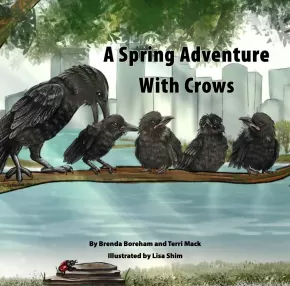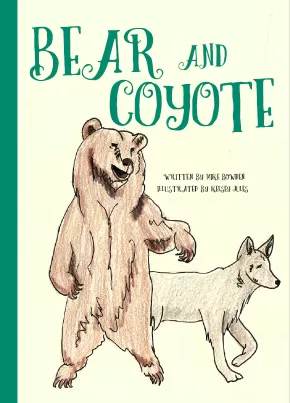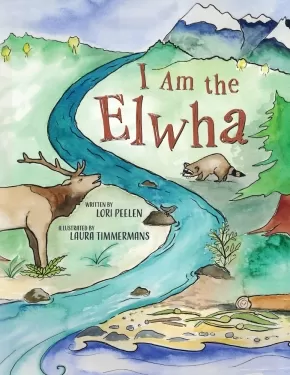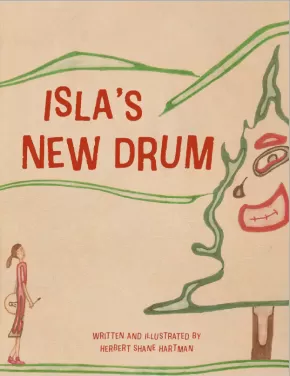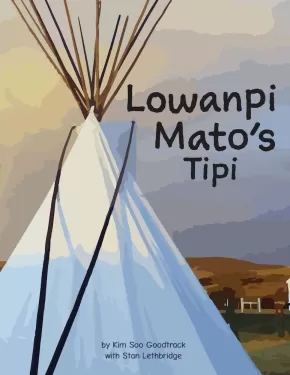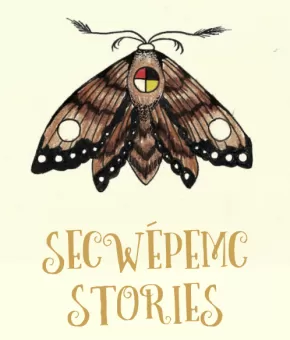
*By Grade
61
-
75
of
278 Results;
Sort By
Go To
of 19
A Spring Adventure With Crows
 $11.95
$11.95

Artists:
Format:
Paperback
ISBN / Barcode: 9781771745680
Synopsis:
Synopsis:
“The fledgling lands safely at the foot of the tree. He looks around. He sees a ladybug crawling along the leaf of a stinging nettle. He is curious. Is it good to eat? He hops up onto a smooth, black rock to take a closer look.”
This book uses both fiction and non-fiction as a unique approach to storytelling.
On left-hand pages, lyrical text and colourful illustrations tell a story of a young crow’s early morning spring adventure. Using his senses, the fledgling discovers the world around his nest. Expertly woven into this delightful story are interesting facts about crows and other plants and animals in a city park.
Captioned and labelled photographs, word boxes, a diagram, and a map make the non-fiction portion of this book an accessible source of information for young readers.
Educator & Series Information
This book is part of the A Spring Adventure series.
Recommended for grades 2 and 3.
Captioned and labelled photographs, word boxes, a diagram, and a map make the non-fiction portion of this book an accessible source of information for young readers.
Science Connections: Biodiversity, animal classification, food chains, life cycles, ecosystems, geology, and the connections between living and non-living things are some of the concepts included in this book.
Additional Information
24 Pages | 8" x 8" | ISBN: 978-1-77174-568-0 | Paperback
A Spring Adventure With Deer
 $11.95
$11.95

Artists:
Format:
Paperback
ISBN / Barcode: 9781771745659
Synopsis:
Synopsis:
“The buzzing sound fades away when the bee flies off. The fawn twitches his large ears and looks about. He can hear trickling water close by. He walks to the far side of the meadow, down a rocky bank, and to a little creek below.”
This book uses both fiction and non-fiction as a unique approach to storytelling.
On left-hand pages, lyrical text and colourful illustrations tell a story of a young fawn’s early morning spring adventure. Using his senses, the fawn discovers the world around him while searching for his mother. Expertly woven into this delightful story are interesting facts about black-tailed deer and other plants and animals in a forest ecosystem.
Captioned and labelled photographs, word boxes, a diagram, and a map make the non-fiction portion of this book an accessible source of information for young readers.
Educator & Series Information
This book is part of the A Spring Adventure series.
Recommended for grades 2 and 3.
Captioned and labelled photographs, word boxes, a diagram, and a map make the non-fiction portion of this book an accessible source of information for young readers.
Science Connections: Biodiversity, animal classification, food chains, life cycles, ecosystems, geology, and the connections between living and non-living things are some of the concepts included in this book.
Additional Information
24 Pages | 8" x 8" | ISBN: 978-1-77174-565-9 | Paperback
A Spring Adventure With Robins
 $11.95
$11.95

Artists:
Format:
Paperback
ISBN / Barcode: 9781771745666
Synopsis:
Synopsis:
“The fledgling lands in the dry leaves, cones, and twigs on the forest floor. He stops for a moment. He looks around. He is wondering about the little flowers on the kinnikinnick plants. Are they food? He hops up onto a nearby rock to take a closer look.”
This book uses both fiction and non-fiction as a unique approach to storytelling.
On left-hand pages, lyrical text and colourful illustrations tell a story of a young robin’s early morning spring adventure. Using his senses, the fledgling discovers the world around his nest. Expertly woven into this delightful story are interesting facts about robins and other plants and animals in a forest ecosystem.
Captioned and labelled photographs, word boxes, a diagram, and a map make the non-fiction portion of this book an accessible source of information for young readers.
Educator & Series Information
This book is part of the A Spring Adventure series.
Recommended for grades 2 and 3.
Captioned and labelled photographs, word boxes, a diagram, and a map make the non-fiction portion of this book an accessible source of information for young readers.
Science Connections: Biodiversity, animal classification, food chains, life cycles, ecosystems, geology, and the connections between living and non-living things are some of the concepts included in this book.
Additional Information
24 Pages | 8" x 8" | ISBN: 978-1-77174-566-6 | Paperback
Bear and Coyote (PB)
 $11.95
$11.95

Artists:
Format:
Paperback
Text Content Territories:
Indigenous Canadian; First Nations; Salish; Interior Salish; Secwepemc (Shuswap);
ISBN / Barcode: 9781771745703
Synopsis:
Synopsis:
Kenkéknem (Bear) and Sek̓lép (Coyote) are both busy preparing for the long winter months ahead. Kenkéknem eats berries while Sek̓lép dries salmon and bakes Bannock. They have always done this separately and do not want to share with each other. However, this year Kenkéknem is curious about what Sek̓lép is doing, and he is also very hungry. Kenkéknem curiosity and hunger soon get them both in trouble. This forces them to work and learn together to find out how to solve their problem. In the process, they learn through shared experiences and reflect together. They then discover that they have many new stories to share and new ways to prepare food together.
They gather their relations to share their stories in a wider circle of community in order to share this way of learning through connectedness and relationships.
Bear and Coyote tells the creation story of traditional foods and shows the possibilities that arise when we work together. This book makes for a great bedtime story or read-aloud in the classroom.
The back of the book includes recipes for Bannock (Sp̓ íxle7cw) and Saskatoon Berry Jam (Speqpeq7úw̓l).
Bear and Coyote complements other works by Mike Bowden and Kelsey Jules, including Chief Goose and Porcupine, and includes a familiar character from Four Winds.
Educator & Series Information
Recommended for grades 3 to 7.
This book is part of the Secwépemc Stories series.
This story is a great resource to introduce Indigenous languages to young readers. Secwepemctsín is one of 30 distinct Indigenous languages in British Columbia and is in the process of being revitalized after governments and religions developed policies to eliminate the rich language and culture of Indigenous peoples. The book integrates Secwépemc words into the text and includes a pronunciation guide on every page.
This story connects to the BC First Principles of Learning: learning is holistic, reflexive, experiential, and relational; learning involves the consequences of one’s actions; learning is embedded in story; and learning involves patience and time. Learning from Indigenous stories can be different and personal every time a story is read or told, depending on context. This book provides opportunity for those reading to reflect, explore, connect, and learn on a personal interpretative level.
Curriculum links:
- Social emotional learning: cooperation, working together, reciprocal relationships
- Reading and language skills
- Numeracy: includes recipes and encourages young learners to measure and count ingredients
- Food: gathering, preparing, and cooking traditional foods
- Indigenous knowledge and traditions
Additional Information
24 Pages | Colour illustrations | 22 x 28 cm | ISBN: 9781771745703 | Paperback
Chief Goose (PB)
 $11.95
$11.95

Artists:
Format:
Paperback
Text Content Territories:
Indigenous Canadian; First Nations; Salish; Interior Salish; Secwepemc (Shuswap);
ISBN / Barcode: 9781771745697
Synopsis:
Synopsis:
Kúkwpi7 K̓wsucw (Chief Goose) is the leader of the k̓wsucw (geese). As a leader, he relies on doing things the way his people have always done and does not want to change anything. But his people are not prepared for the long winter and Kúkwpi7 K̓wsucw realizes it is time for him to be a true leader. Following ancient protocols, he first consults the great spirit for guidance and wisdom. Then he begins the journey to lead his people in search for a better place to live during the long winter season. Through trial and error, he learns that listening to others and allowing his people to help him lead is the path to the well-being of the k̓wsucw.
Chief Goose tells the story of why geese fly south for the winter and is the perfect bedtime story or read-aloud for classrooms.
This book complements other works by Mike Bowden and Kelsey Jules, including Four Winds, Porcupine, and Bear and Coyote.
Educator Information
Recommended for grades 3 to 7.
This book is part of the Secwépemc Stories series.
This story is a great resource to introduce Indigenous languages to young readers. Secwepemctsín is one of 30 distinct Indigenous languages in British Columbia and is in the process of being revitalized after governments and religions developed policies to eliminate the rich language and culture of Indigenous peoples. The book integrates Secwépemc words into the text and includes a pronunciation guide on every page.
This story connects to the BC First Peoples’ Principles of Learning: learning is holistic, reflexive, experiential, and relational; learning involves the consequences of one’s actions; learning is embedded in story; and learning involves patience and time. Learning from Indigenous stories can be different and personal every time a story is read or told, depending on context. This book provides an opportunity for those reading to reflect, explore, connect, and learn on a personal interpretative level.
Curriculum links:
- Social emotional learning: leadership, listening, social awareness, learning from mistakes and trying again
- Reading and language skills
- Indigenous knowledge and traditions
Additional Information
24 Pages | Colour illustrations | 22 x 28 cm | ISBN: 9781771745697 | Paperback
I Am Like a TREE Series Bundle
 $41.40 $46.00
$41.40 $46.00

Text Content Territories:
Indigenous Canadian;
ISBN / Barcode: 9781771745826
Synopsis:
Synopsis:
Included in this bundle are all four titles in the I Am Like a TREE series:
I Am Like a TREE: BARK and KNOTS – A Story of Courage and Struggles
I Am Like a TREE: LEAVES and BRANCHES – A Story of Belonging and Growth
I Am Like a TREE: SEEDS and LEAVES – A Story of Self Care and Belonging
I Am Like a TREE: TRUNK and ROOTS – A Story of Self and Empathy
The TREE in this series is a metaphor for what we are calling your “Present Self”. Our belief, through personal experience, is that we as living beings have several emotional parts that make us a whole, our Present Self. Each of these parts though are not equal in their emotional experience, so at times, different situations for an individual can be strong while at other times not. Some experiences can keep us in a frozen stage of development without knowing this and we then respond to “like type” experiences in the same way as we did in the past.
Our intention with these conversational stories in a reader’s theatre format is to provide a window into what emotional parts a person may use while having a conversation. The side margins tell all as each conversation unfolds indicating what parts of TREE the character is using. Some of these conversations are focused on the older individual trying to find a solution while the younger individual is providing support as best they can, as a solid TREE. Our intent is to imply that emotional learning is lifelong.
We hope that through these stories we will all continue to extend a hand to those who are reaching, listen to those who are speaking, and feel with an open heart to all those heartbeats that surround us. And for ourselves, love who you are, respect your own actions, and know that you deserve kindness, love and safety and that you belong here.
The back cover introduction and content overview inside make the books in the I Am Like a TREE series great for many learning situations. In each book are four discussion questions that focus on comprehension strategies and mental, physical, emotional, and spiritual connections. The books also provide an inquiry theme to explore and include five activity ideas for independent or group use.
Scroll below to learn more about each work included in this bundle.
Additional Information
ISBN: 9781771745826
I Am Like a TREE: BARK and KNOTS - A Story About Courage and Struggles
 $11.50
$11.50

Artists:
Format:
Paperback
Text Content Territories:
Indigenous Canadian;
ISBN / Barcode: 9781771745642
Synopsis:
Synopsis:
Conversations are important for everyone. Some conversations can only occur when we feel brave enough to say our words out loud. By talking with those who offer to listen and connect respectfully, we can grow emotionally. We can also learn ways to help others shine. By discovering, growing, and learning about the many emotional parts of ourselves and others, we can find our Present Self.
Follow along in this conversation that connects our emotional parts of ourselves to TREE (our Present Self). As BARK (Courage) and our KNOTS (Struggles) communicate, we learn that our parts grow inside of us so we can be just like a strong, healthy, and growing TREE.
Educator & Series Information
Recommended for Grades 4+
The back cover introduction and content overview inside make the books in the I Am Like a TREE series great for many learning situations. In each book are four discussion questions that focus on comprehension strategies and mental, physical, emotional, and spiritual connections. The books also provide an inquiry theme to explore and include five activity ideas for independent or group use.
This book is part of the social-emotional learning (SEL) series, I Am Like a TREE. I Am Like a TREE series consists of four titles:
I Am Like a TREE: BARK and KNOTS – A Story of Courage and Struggles
I Am Like a TREE: LEAVES and BRANCHES – A Story of Belonging and Growth
I Am Like a TREE: SEEDS and LEAVES – A Story of Self Care and Belonging
I Am Like a TREE: TRUNK and ROOTS – A Story of Self and Empathy
The TREE in this series is a metaphor for what we are calling your “Present Self”. Our belief, through personal experience, is that we as living beings have several emotional parts that make us a whole, our Present Self. Each of these parts though are not equal in their emotional experience, so, at times, different situations for an individual can be strong while at other times not. Some experiences can keep us in a frozen stage of development without knowing this and we then respond to “like type” experiences in the same way as we did in the past.
Our intention with these conversational stories in a reader’s theatre format is to provide a window into what emotional parts a person may use while having a conversation. The side margins tell all as each conversation unfolds indicating what parts of TREE the character is using. Some of these conversations are focused on the older individual trying to find a solution while the younger individual is providing support as best they can, as a solid TREE. Our intent is to imply that emotional learning is lifelong.
We hope that through these stories we will all continue to extend a hand to those who are reaching, listen to those who are speaking, and feel with an open heart to all those heartbeats that surround us. And for ourselves, love who you are, respect your own actions, and know that you deserve kindness, love and safety and that you belong here.
Additional Information
24 Pages | 8" x 8" | ISBN: 9781771745642 | Paperback
I Am Like a TREE: LEAVES and BRANCHES - A Story of Belonging and Growth
 $11.50
$11.50

Artists:
Format:
Paperback
Text Content Territories:
Indigenous Canadian;
ISBN / Barcode: 9781771745628
Synopsis:
Synopsis:
Conversations are important for everyone. Some conversations can only occur when we feel understood. By talking with others, we can learn new ways to be respectful, kind, and empathetic. As we deepen our learning, we become more aware of our own actions. By discovering, growing, and learning about the many emotional parts of ourselves and others, we can find our Present Self.
Follow along in this conversation that connects our emotional parts of ourselves to TREE (our Present Self). As LEAVES (Belonging) and BRANCHES (Growth) communicate, we learn that our parts protect us so we can be just like a strong, healthy, and growing TREE.
Educator & Series Information
Recommended for Grades 4+
The back cover introduction and content overview inside make the books in the I Am Like a TREE series great for many learning situations. In each book are four discussion questions that focus on comprehension strategies and mental, physical, emotional, and spiritual connections. The books also provide an inquiry theme to explore and include five activity ideas for independent or group use.
This book is part of the social-emotional learning (SEL) series, I Am Like a TREE. I Am Like a TREE series consists of four titles:
I Am Like a TREE: BARK and KNOTS – A Story of Courage and Struggles
I Am Like a TREE: LEAVES and BRANCHES – A Story of Belonging and Growth
I Am Like a TREE: SEEDS and LEAVES – A Story of Self Care and Belonging
I Am Like a TREE: TRUNK and ROOTS – A Story of Self and Empathy
The TREE in this series is a metaphor for what we are calling your “Present Self”. Our belief, through personal experience, is that we as living beings have several emotional parts that make us a whole, our Present Self. Each of these parts though are not equal in their emotional experience, so, at times, different situations for an individual can be strong while at other times not. Some experiences can keep us in a frozen stage of development without knowing this and we then respond to “like type” experiences in the same way as we did in the past.
Our intention with these conversational stories in a reader’s theatre format is to provide a window into what emotional parts a person may use while having a conversation. The side margins tell all as each conversation unfolds indicating what parts of TREE the character is using. Some of these conversations are focused on the older individual trying to find a solution while the younger individual is providing support as best they can, as a solid TREE. Our intent is to imply that emotional learning is lifelong.
We hope that through these stories we will all continue to extend a hand to those who are reaching, listen to those who are speaking, and feel with an open heart to all those heartbeats that surround us. And for ourselves, love who you are, respect your own actions, and know that you deserve kindness, love and safety and that you belong here.
Additional Information
24 Pages | 8" x 8" | ISBN: 9781771745628 | Paperback
I Am Like a TREE: SEEDS and LEAVES - A Story About Survival and Belonging
 $11.50
$11.50

Artists:
Format:
Paperback
Text Content Territories:
Indigenous Canadian;
ISBN / Barcode: 9781771745635
Synopsis:
Synopsis:
Conversations are important for everyone. Some conversations can only occur when we have a sense of belonging. By talking with others, we can learn about healthy friendships and about ways to feel safe and protected. By discovering, growing, and learning about the many emotional parts of ourselves and others, we can find our Present Self.
Follow along in this conversation that connects our emotional parts of ourselves to TREE (our Present Self). As SEEDS (Self Care) and LEAVES (Belonging) communicate, we learn that our parts guide us so we can be just like a strong, healthy, and growing TREE.
Educator & Series Information
Recommended for Grades 4+
The back cover introduction and content overview inside make the books in the I Am Like a TREE series great for many learning situations. In each book are four discussion questions that focus on comprehension strategies and mental, physical, emotional, and spiritual connections. The books also provide an inquiry theme to explore and include five activity ideas for independent or group use.
This book is part of the social-emotional learning (SEL) series, I Am Like a TREE. I Am Like a TREE series consists of four titles:
I Am Like a TREE: BARK and KNOTS – A Story of Courage and Struggles
I Am Like a TREE: LEAVES and BRANCHES – A Story of Belonging and Growth
I Am Like a TREE: SEEDS and LEAVES – A Story of Self Care and Belonging
I Am Like a TREE: TRUNK and ROOTS – A Story of Self and Empathy
The TREE in this series is a metaphor for what we are calling your “Present Self”. Our belief, through personal experience, is that we as living beings have several emotional parts that make us a whole, our Present Self. Each of these parts though are not equal in their emotional experience, so, at times, different situations for an individual can be strong while at other times not. Some experiences can keep us in a frozen stage of development without knowing this and we then respond to “like type” experiences in the same way as we did in the past.
Our intention with these conversational stories in a reader’s theatre format is to provide a window into what emotional parts a person may use while having a conversation. The side margins tell all as each conversation unfolds indicating what parts of TREE the character is using. Some of these conversations are focused on the older individual trying to find a solution while the younger individual is providing support as best they can, as a solid TREE. Our intent is to imply that emotional learning is lifelong.
We hope that through these stories we will all continue to extend a hand to those who are reaching, listen to those who are speaking, and feel with an open heart to all those heartbeats that surround us. And for ourselves, love who you are, respect your own actions, and know that you deserve kindness, love and safety and that you belong here.
Additional Information
24 Pages | 8" x 8" | ISBN: 9781771745635 | Paperback
I Am Like a TREE: TRUNK and ROOTS - A Story of Self and Empathy
 $11.50
$11.50

Artists:
Format:
Paperback
Text Content Territories:
Indigenous Canadian;
ISBN / Barcode: 9781771745611
Synopsis:
Synopsis:
Conversations are important for everyone. Some conversations can only occur when we feel understood. By talking with others, we can learn new ways to be respectful, kind, and empathetic. As we deepen our learning, we become more aware of our own actions. By discovering, growing, and learning about the many emotional parts of ourselves and others, we can find our Present Self.
Follow along in this conversation that connects our emotional parts of ourselves to TREE (our Present Self). As TRUNK (Self) and ROOTS (Empathy) communicate, we learn that our parts interconnect so we can be just like a strong, healthy, and growing TREE.
Educator & Series Information
Recommended for Grades 4+
The back cover introduction and content overview inside make the books in the I Am Like a TREE series great for many learning situations. In each book are four discussion questions that focus on comprehension strategies and mental, physical, emotional, and spiritual connections. The books also provide an inquiry theme to explore and include five activity ideas for independent or group use.
This book is part of the social-emotional learning (SEL) series, I Am Like a TREE. I Am Like a TREE series consists of four titles:
I Am Like a TREE: BARK and KNOTS – A Story of Courage and Struggles
I Am Like a TREE: LEAVES and BRANCHES – A Story of Belonging and Growth
I Am Like a TREE: SEEDS and LEAVES – A Story of Self Care and Belonging
I Am Like a TREE: TRUNK and ROOTS – A Story of Self and Empathy
The TREE in this series is a metaphor for what we are calling your “Present Self”. Our belief, through personal experience, is that we as living beings have several emotional parts that make us a whole, our Present Self. Each of these parts though are not equal in their emotional experience, so, at times, different situations for an individual can be strong while at other times not. Some experiences can keep us in a frozen stage of development without knowing this and we then respond to “like type” experiences in the same way as we did in the past.
Our intention with these conversational stories in a reader’s theatre format is to provide a window into what emotional parts a person may use while having a conversation. The side margins tell all as each conversation unfolds indicating what parts of TREE the character is using. Some of these conversations are focused on the older individual trying to find a solution while the younger individual is providing support as best they can, as a solid TREE. Our intent is to imply that emotional learning is lifelong.
We hope that through these stories we will all continue to extend a hand to those who are reaching, listen to those who are speaking, and feel with an open heart to all those heartbeats that surround us. And for ourselves, love who you are, respect your own actions, and know that you deserve kindness, love and safety and that you belong here.
Additional Information
24 Pages | 8" x 8" | ISBN: 9781771745611 | Paperback
I Am the Elwha (HC)
 $18.50
$18.50

Artists:
Format:
Hardcover
Text Content Territories:
Indigenous American; Native American; Salish; Coast Salish; Klallam (Clallam); Lower Elwha Klallam Tribe;
ISBN / Barcode: 9781771744744
Synopsis:
Synopsis:
“I am the Elwha, rushing down to the sea. I am the Elwha, wild and free.”
The Elwha River flows 72 kilometres (45 miles) from its source in the Olympic Mountains to the Strait of Juan de Fuca in the Pacific Northwest. Uniquely, it hosts all six salmon species (Pink, Chinook, Coho, Sockeye, Steelhead, and Chum) as well as several species of trout.
In 1911 two dams were built on the river. The dams blocked the migration routes of the salmon and dramatically altered the entire river ecosystem for 100 years. In 2012 the dams were decommissioned and the world’s largest dam removal and habitat restoration project began.
In this lyrical and beautifully illustrated book, the author chronicles the history of the Elwha. Narrated by the powerful voices of plants and animals that inhabit the river ecosystem, the dam builder, a worker, and the river itself, this story celebrates the ongoing rewilding of this special environment and offers a welcome to all of the creatures who are coming home.
To learn more visit: www.elwha.org
Awards
- 2021 Riverby Award for Young Readers
Reviews
“I Am the Elwha is a powerful read about a powerful river and those who value and protect it." – Raina Delisle, Hakai Magazine
Educator Information
At the back of the book are three pages of cultural, scientific, and historical information that discuss the following:
- the importance and symbolism of salmon to the Lower Elwha Klallam Tribe and other Coastal Salish Tribes
- facts about the six species of salmon found in the Elwha River (Chinook, Pink, Chum, Sockeye, Coho, and Steelhead)
- the history of the Elwha River and its status today
Keywords / Subjects: The Elwha River, Rivers, Dams, History, Environmental Awareness, Lower Elwha Klallam Tribe, Coast Salish, Native American, Culture, Washington, Animals, Salmon, First Salmon Ceremony, Plants, Nature, Settlers, Social Responsibility, Environmental Activism, Poetry.
Recommended for grades 3 to 7.
Additional Information
32 Pages | 8.5" x 11" | ISBN: 9781771744744 | Hardcover
Authenticity Note: This lyrical story, which chronicles the history of the Elwha River, is written by Lori Peelen. Robert Elofson, Tribal Elder and Harvest Manager in the Natural Resources Department for the Lower Elwha Klallam Tribes, approved Lori's work and contributed a few pages of back matter at the end of the work. Lori's story was further approved by Frances Charles, the Tribal Councilwoman for the Lower Elwha Klallam Tribe, after the entire council read and approved it.
The Canadian Content label has been applied because the illustrator of this work is Canadian.
Isla's New Drum
 $12.50
$12.50

Format:
Paperback
Text Content Territories:
Indigenous Canadian; First Nations; Dene; Dakelh (Carrier); Nak’azdli Whut’en;
ISBN / Barcode: 9781771745574
Synopsis:
Synopsis:
Isla’s New Drum is Shane Hartman’s debut children’s book. The story is a contemporary story that Shane wrote for his daughter after he had made her a drum and gifted it to her. Isla loved her new drum!
Isla has been given a new drum that she loves dearly but she doesn’t have a song to sing to her new drumbeat,
Boom ba ba boom
Boom ba ba boom
Boom ba ba boom boom
So, Isla decides to ask some forest friends to help her make a new song. Each friend offers Isla what they can, showing true generosity. Each friend also offers a message that is important to keeping Mother Earth healthy and strong. In return, Isla plays her drum for each friend as she gives back what she can. Isla discovers so much more than her new song!
Educator Information
The Dakelh (Carrier) words included in this book were referenced from The Central Carrier Bilingual Dictionary. The Carrier Language belongs to the Athapaskan language family and has three major dialects: Northern - Babine Lake, Central - Stuart lake, Southern - locations as far south as Anahim Lake.
Keywords / Themes: Drum; Indigenous Canadian, Environmental Awareness, Friendship, Music; Nak'azdli Whut'en.
Recommended for Preschool - Grade 1
Additional Information
32 pages | Colour illustrations | 8.5" x 11" | ISBN: 9781771745574 | Paperback
Lowanpi Mato’s Tipi
 $18.50
$18.50

Artists:
Format:
Hardcover
Text Content Territories:
Indigenous Canadian; First Nations; Sioux; Lakota;
ISBN / Barcode: 9781771744751
Synopsis:
Synopsis:
“Hokahe! Welcome!”
Welcome to Wood Mountain, home of the Lakota People, in southern Saskatchewan. It is here that we meet Stan Lethbridge, whose ancestral name is Lowanpi Mato (Singing Bear).
Join Lowanpi Mato as he prepares to set up his summer Tipi. He shares with us Lakota life values and traditions, and how they connect to building and taking care of a Tipi. He teaches us that to build a Tipi you need many items; some are from natural sources and others are purchased from a store. Lowanpi Mato takes us through a step-by-step building process so that we can all learn how a Tipi is built.
The Lakota language is woven throughout the story. The Lakota counting chart on pages 30 and 31 invites you to learn to count and have some fun looking back through the book to find items that match each number.
Welcome to Wood Mountain, home of the Lakota People, in southern Saskatchewan. It is here that we meet Stan Lethbridge, whose ancestral name is Lowanpi Mato (Singing Bear).
Join Lowanpi Mato as he prepares to set up his summer Tipi. He shares with us Lakota life values and traditions, and how they connect to building and taking care of a Tipi. He teaches us that to build a Tipi you need many items; some are from natural sources and others are purchased from a store. Lowanpi Mato takes us through a step-by-step building process so that we can all learn how a Tipi is built.
The Lakota language is woven throughout the story. The Lakota counting chart on pages 30 and 31 invites you to learn to count and have some fun looking back through the book to find items that match each number.
Educator Information
Lakota language is woven throughout this story, as are the seven values of Lakota life.
Lakota language is woven throughout this story, as are the seven values of Lakota life.
Includes a counting chart from 1 to 20 in Lakota, as well as a search-and-find counting game.
Additional Information
32 pages | 8.5" x 11" | Hardcover | ISBN: 9781771744751
32 pages | 8.5" x 11" | Hardcover | ISBN: 9781771744751
Porcupine (PB)
 $11.95
$11.95

Artists:
Format:
Paperback
Text Content Territories:
Indigenous Canadian; First Nations; Salish; Interior Salish; Secwepemc (Shuswap);
ISBN / Barcode: 9781771745710
Synopsis:
Synopsis:
Kú7pece (Porcupine) has always struggled with his emotions and pushed his relations away. Kú7pece does not like this part of himself and wants to explore his identity and learn more about himself, his family, and the land.
To connect with his relations and his friends, Kú7pece decides to build a gathering place: a c7ístkten̓ (winter home). This is a place he is hoping his relations can gather and learn about each other through sharing stories. However, Kú7pece traps the sun and soon gets distracted by the sun’s heat and light. So much so, he forgets who he is and his purpose. Soon he is trapped too and cannot see that he is neglecting his responsibilities.
It takes the sacrifice of his relations and friends to help him realize he was trapped in his own reality. Once he realizes the lesson of the sacrifice of his friends – that they were trying to help him reconnect to his own place and purpose – he uses all his courage to turn away from the sun’s heat and light. Slowly, he remembers his identity, purpose, and responsibilities. In the end, Kú7pece finds himself again and reconnects with his relations to gather to tell stories, learn from each other, and support one another.
Porcupine is a story about expressing emotions and being considerate to the needs of others. It works well as a bedtime story or read-aloud for classrooms.
This book works well with others by Mike Bowden and Kelsey Jules, including Four Winds, Bear and Coyote, and Chief Goose.
Educator Information
Recommended for grades 3 to 7.
This book is part of the Secwépemc Stories series.
This story is a great resource to introduce Indigenous languages to young readers. Secwepemctsín is one of 30 distinct Indigenous languages in British Columbia and is in the process of being revitalized after governments and religions developed policies to eliminate the rich language and culture of Indigenous peoples. The book integrates Secwépemc words into the text and includes a pronunciation guide on every page.
This story connects to the BC First Peoples’ Principles of Learning: learning is holistic, reflexive, experiential, and relational; learning involves the consequences of one’s actions; learning is embedded in story; and learning involves patience and time. Learning from Indigenous stories can be different and personal every time a story is read or told, depending on context. This book provides an opportunity for those reading to reflect, explore, connect, and learn on a personal interpretative level.
Curriculum links:
- Social emotional learning: identity, self-awareness, emotions, family, community, relationship skills
- Reading and language skills
- Indigenous knowledge and traditions
Additional Information
24 Pages | Colour illustrations | 22 x 28 cm | ISBN: 9781771745710 | Paperback
Secwépemc Stories Bundle
 $48.92 $54.35
$48.92 $54.35

Text Content Territories:
Indigenous Canadian; First Nations; Salish; Interior Salish; Secwepemc (Shuswap);
ISBN / Barcode: 9781771746632
Synopsis:
Synopsis:
This bundle includes all four Secwépemc stories from Mike Bowden:
- Four Winds (hardcover)
- Porcupine (paperback)
- Bear and Coyote (paperback)
- Chief Goose (paperback)
Secwépemc Stories are the collaborative work of Secwépemc author Mike Bowden and Secwépemc artist Kelsey Jules. These stories convey Secwépemc teachings and embody Indigenous ways of knowing. Mike, a storyteller and educator, strongly believes in story as a way of learning and understanding the world and our relationships within it. Secwépemc language is integrated into the stories and accompanied by pronunciation guides.
These stories connect to the BC First Peoples principles of learning and provide opportunities for those reading to reflect, explore, connect and learn on a personal interpretative level.
Additional Information
Books are 8.5" x 11" | 24 Pages | ISBN 9781771746632
Scroll below to learn more about each book included.
Sort By
Go To
of 19

